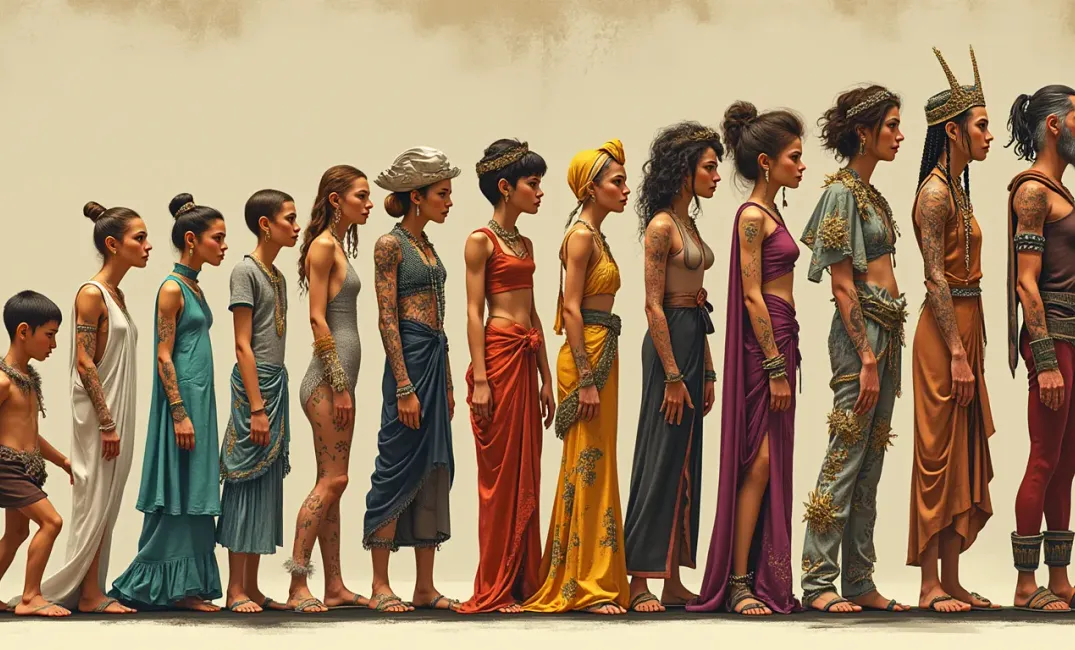Introduction: Fashion as a Cultural Canvas
Fashion is more than mere attire; it's a dynamic expression of human identity, cultural diversity, and social change. As both a personal and collective art, fashion narrates humanity's journey through its shifts and turns. Clothing choices, interwoven with cultural narratives, technological advancements, and historical events, reveal who we are and where we've been. This exploration delves into fashion's role as a societal mirror, charting its evolution from ancient garments to futuristic designs that shape identities and reflect global trends.
"Fashion is not something that exists in dresses only. Fashion is in the sky, in the street; fashion has to do with ideas, the way we live, what is happening." — Coco Chanel
The Historical Roots of Fashion
Ancient Attire: Function and Status
- Prehistoric Clothing: The earliest clothing developments were driven by necessity, with primitive humans using natural materials such as animal skins and plant fibers to protect themselves from environmental elements. These garments also began reflecting social structures, as adornments signaled status and tribal affiliation.
- Symbolism in Antiquity: In ancient civilizations—Egypt, Mesopotamia, and Greece—clothing signaled wealth, rank, and divine favor. Luxurious fabrics and intricate designs distinguished the elite. For example, the Egyptians favored linen for its cooling properties, while silks defined ancient Chinese attire, symbolizing prosperity.
Medieval and Renaissance Garb
- Medieval Hierarchies and Regulation: Fashion in the Middle Ages was deeply entwined with societal hierarchies and moral codes. Nobility showcased their power through opulent attire, leading to sumptuary laws aimed at preserving class distinctions by restricting extravagant fashion to the elite.
- Renaissance Innovation and Experimentation: The Renaissance revived interest in art and individuality, with fashion becoming an arena for bold experimentation. Influences from abroad, such as the introduction of elaborate lace from the Low Countries, diversified styles and signaled a shift toward personal expression.
Fashion's Evolution Across Modern Eras
The 18th and 19th Centuries: Revolution and Romanticism
- Enlightenment and Democratic Dress: The Age of Enlightenment propagated ideals of equality and rationality, reflected in simplified silhouettes and muted colors. The French Revolution further democratized fashion, rejecting ornate aristocratic styles in favor of practicality.
- Industrialization and Mass Production: The Industrial Revolution transformed fashion through mechanized textile production, making clothing accessible to broader audiences and resulting in the emergence of department stores, ready-to-wear clothing, and the concept of fashion seasons.
The 20th Century: Decades of Dynamic Change
- Roaring Twenties to Wartime Utility: Post-WWI liberation spawned radical shifts in women's fashion, marked by shorter hemlines and androgynous silhouettes epitomized by the flapper style. The WWII era inspired utilitarian designs, with fashion adapting to material shortages and societal roles shifting dramatically.
- Post-War Prosperity and Cultural Revolutions: The post-WWII era brought prosperity and consumerism, birthing vibrant subcultures. The rise of youth-driven trends in the 1960s and 1970s, such as punk and hippie fashion, challenged norms, embodying values of rebellion and freedom.
The Globalization of Fashion
Cross-Cultural Influences and Innovation
- Fashion as a Global Phenomenon: Globalization has woven cultural tapestry into fashion, with traditional motifs inspiring modern interpretations. The Western fashion industry's rise throughout the 20th century met with influences from Asia, Africa, and the Middle East, creating hybrid styles.
- Technology and Media: The digital age revolutionized fashion through instant communication, online retail, and social media. Fashion no longer abides by geographical boundaries; its rapid dissemination creates transnational trends, empowering diverse voices and expanding cultural dialogues.
Sustainability and Ethical Challenges
- The Environmental Impact of Fashion: The fashion industry's ecological footprint has ballooned, challenging norms of fast fashion with rising awareness of sustainable practices. Consumers, driven by eco-consciousness, demand transparency and quality over quantity, fostering a shift towards slow fashion.
- Ethical Production and Inclusivity: Modern fashion endeavors to address labor practices and representation. Advocates emphasize ethical sourcing, fair trade, and inclusivity, championing diversity with broader representation of body types, gender identities, and cultural narratives.
Fashion as an Art Form and Identity Marker
Expression through Attire
- Personal and Political Statements: Fashion is an extension of self-expression, allowing individuals to convey beliefs, affiliations, and emotions. Political movements frequently employ clothing as a symbol of defiance and advocacy, from suffragette whites to Black Lives Matter merchandise.
- Identity and Subcultures: Subcultures utilize fashion to bond members and delineate collective identity. From goth to cosplay, fashion facilitates a sense of belonging, transforming societal margins through acceptance and undue recognition, inviting innovation and eccentricity.
The Future of Fashion
- Technology and Innovation: As technology envelops fashion, innovations such as smart textiles, 3D printing, and augmented reality redefine possibilities. Technology-driven customizations and virtual try-ons democratize access to personal styles, reshaping consumer engagement.
- Cultural Sensitivity and Design: Designers strive to honor culture and heritage, balancing creative autonomy with respect. The fashion industry's ability, and duty, to tell stories can empower marginalized communities, preserving craftsmanship while engaging in meaningful dialogues.
Conclusion: Weaving Humanity's Future Through Fashion
Fashion endures as an eloquent reflection of society, encompassing its vast complexities, ambitions, and identities. In continuity and transformation, it articulates fleeting trends and timeless aesthetics, uniting cultures, celebrating diversity, and inspiring innovations.
"Fashion fades, only style remains the same." — Yves Saint Laurent
As humans traverse this unprecedented cosmic voyage, fashion shall accompany them as an enduring archive of collective human experiences, preserving traditions, advancing creativity, and prompting new expressions of identity—an eternal journey spurred by imagination and shared humanity.
IDENTITY, GLOBALIZATION, SUSTAINABILITY, TECHNOLOGY, INNOVATION, FASHION, DIVERSITY, CULTURE, ART, HISTORY

